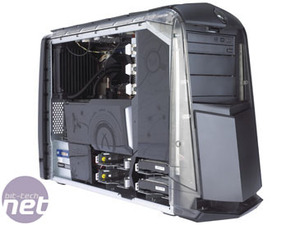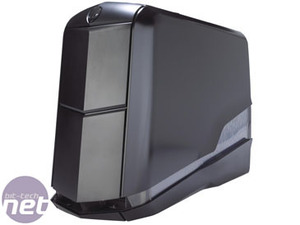
Performance
As we mentioned earlier, our testing was hampered by one of the DIMMs being installed in the wrong slot. Once we had corrected this fault we were able to get going, with the Aurora ALX achieving an overall score of 1,592 in our batch of media benchmarks. This is a decent result, but it pales in comparison with the far cheaper overclocked Intel Core i5-750 and HD 5850 based £800 Yoyotech Warbird i750X system we reviewed in Custom PC a few months back, which achieved 2,025 across the same battery of tests thanks to its overclocked 4GHz CPU.Of course it was only fair to attempt to squeeze more performance out of the Aurora ALX, so we delved into the BIOS and activated the Level 1 overclock option – oddly named as it’s the only option there. Annoyingly though there's no indication your overclock has been applied unless you restart your system. With the one setting overclock enabled we found the BIOS had pushed up the QPI to 160MHz, boosting the CPU from 2.66GHz to 3.2GHz. This improved the overall media benchmark score to 1,778, but with the Warbird i750X hanging tough at 4GHz and with a score 2025, the Aurora ALX still couldn't compete.
At this point we were all set to get down and dirty with some manual overclocking via the BIOS. However, after trying a few settings and receiving a ‘missing operating system’ message, our testing was brought to an abrupt end. RAID 0 strikes again.
The HD 5870 graphics card in the Aurora ALX is naturally a faster graphics card than the HD 5850 in the Warbird i750X, and the Aurora ALX therefore outperforms the Warbird i750X in Crysis. At 1,680 x 1,050, the Aurora ALX hits a probably CPU limited 22fps minimum and 53fps average; a very acceptable frame rate with plenty of room for AA or a move upto 1,920 x 1080. Overclocking the system helped alleiviate the CPU block though, and upped the minimum frame rate by 11fps. We gave the Aurora ALX a work-out in the easier to handle Dirt 2 as well, but even with its Direct X 11 mode enabled the mud-strewn tracks were easy meat, with a silky smooth minimum frame rate of 51fps at 1,920 x 1,080 with 4x AA.
When all is said and done though, while the Aurora ALX clearly isn’t slow, nothing can hide the fact that in raw performance terms it’s humbled by a pre-overclocked £800 machine in many circumstances.
Conclusion
At the start of this review we asked if Alienware had managed to crack the value and performance nut with the Aurora ALX – and the straight answer is no.True, no other PC you can buy off the shelf has a case with dramatic flaring vents and controllable lighting, but we really can’t see where £1,900+ worth of components and engineering has gone when looking at the Aurora ALX. This is where Alienware’s BMW M-series comparisons fall down. With the M-division cars, every modification is made to enhance performance. Valve timings are tightened, the EPU is reprogrammed, suspensions stiffened. While we like the customisable lighting, the innovative internal light and rising vents in the Aurora ALX, we’re not convinced any of these extras add to anything the PC other than enhancing your electronic ego, leaving the Aurora ALX's performance some way behind comparably priced and even cheaper, pre-overclocked systems.
We remain unconvinced by the CoolIT Domino and are enormously sceptical about the role the vents actually play in cooling, especially as there's only one 120mm fan in the whole case. It’s also disappointing that Alienware doesn’t pre-overclock the CPU as standard, a feature reserved for the much more expensive Area 51 systems.
Extending the motoring analogy, when you take performance into account, the Aurora ALX is the guy who turns up at the motoring track day clad in professional-branded overalls and cap, only to be torn apart by the slouch in shorts and T-shirt. In short, the vents and the light show are more Max Power than real M-class improvements. If you’re happy to part with this much cash, you’ll get a powerful machine, but just be clear you’re paying over the odds for the drama and the lightshow, not real world performance where it counts.
- Performance
- x
- x
- x
- x
- x
- x
- x
- -
- -
- -
- 7/10
- Features
- x
- x
- x
- x
- x
- x
- x
- x
- -
- -
- 8/10
- Value
- x
- x
- x
- x
- -
- -
- -
- -
- -
- -
- 4/10
- Overall
- x
- x
- x
- x
- x
- x
- -
- -
- -
- -
- 6/10

MSI MPG Velox 100R Chassis Review
October 14 2021 | 15:04










Want to comment? Please log in.